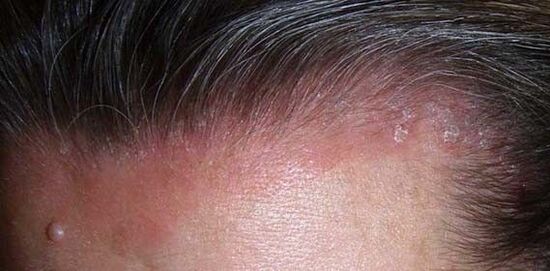
The very first manifestations of psoriasis often appear on the head, and then spread throughout the body. Psoriasis on the head occurs with itching and the risk of bacterial complications. If you suspect the psoriatic nature of the rashes, you should immediately consult a doctor - the disease responds well to treatment from the very beginning. The article contains all the information about the symptoms and all the known treatments for this form of the disease.
Causes of psoriasis on the head
This is a chronic, non-contagious dermatological process that develops in people with hereditary predisposition. The causes of psoriasis on the head and the mechanism of its development are not fully understood. However, it was found that the process develops against the background of metabolic and immune disorders. The body loses control over the division of skin epithelial cells: they begin to divide much faster. Signs of cornification appear just as quickly, which manifest themselves in the form of peeling. At the same time, inflammatory processes develop in the skin.
Main cause of scalp psoriasisis a hereditary predisposition. Scientists are trying to identify the genes responsible for transmitting the disease from generation to generation. Separate altered areas linked to different genes found in patients and their close relatives have already been identified.
But a person who has a genetic predisposition does not necessarily get sick. Equally important are external and internal predisposing factors. Scalp psoriasis begins in genetically predisposed individuals due to exposure to the following factors:
- mechanical irritation of the skin (with a hairbrush with hard teeth; injury of small wounds and crusts that appear with seborrhea, etc. );
- exposure to cold;
- transmitted infectious diseases; often after streptococcal impetigo - purulent rashes mainly on the skin of the face; develops in children and becomes the impetus for the development of an autoimmune process;
- chronic stress and high loads;
- frequent smoking, alcohol abuse;
- Nutritional disorders - irregular malnutrition dry food, excessive consumption of high-calorie foods and hot spices;
- with hormonal disorders affecting the state of the sebaceous glands of the skin - obesity, imbalance of sex hormones, diabetes mellitus, diseases of the thyroid, pituitary, hypothalamus;
- in diseases of the liver and kidneys with impaired function of these organs; Toxins are neutralized in the liver and eliminated from the body through the kidneys. Intoxication can become a starting point in the development of the disease.
Under the influence of one or more factors, the interaction of the organism with the environment is disrupted. The protein, fat and carbohydrate metabolism is disturbed, which leads to an acceleration of the metabolic processes in the skin and their detachment.
Psoriasis of any localization can spread throughout the body, so do not delay treatment.
Changes in the immune system are manifested in the form of increased sensitivity of the skin to external influences (besides combing or frequent hair coloring). In response to such influences, antibodies are produced against their own cells, which provokes the occurrence of an autoimmune inflammatory process. The reasons for the onset of inflammation are not yet fully understood. This is one of the priorities of medicine towards the treatment of psoriasis.
Symptoms of scalp psoriasis
Psoriasis on the head manifests itself in the form of characteristic symptoms. The disease can begin acutely with multiple rashes (vulgar form of psoriasis) or gradually with itching and flaking of the skin, and only then characteristic rashes appear (seborrheic form).
More common onset is gradual, in the form of scaling and flaking. In the early stages, these are small areas in the occipital region. The peeling spreads to larger areas and itching begins. Constant scratching of the skin contributes to its coarsening and the appearance of abrasions. What does scalp psoriasis look like? The first symptoms of psoriasis on the head in the photo look like this:
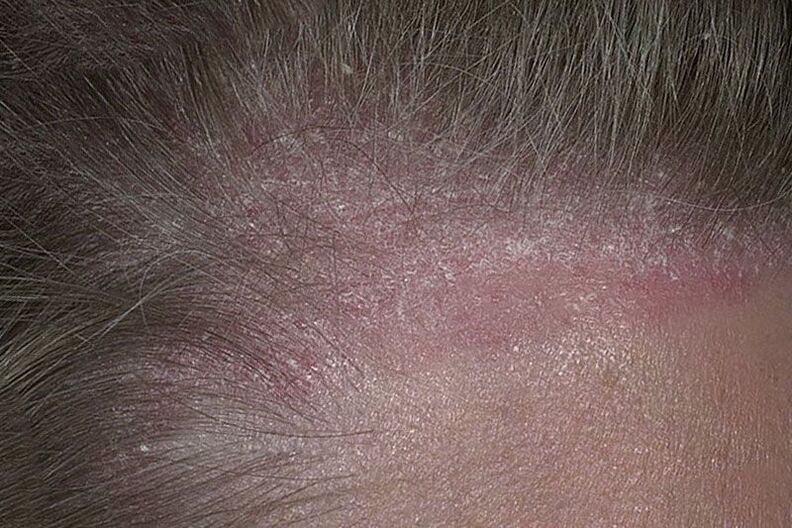
In the area of scratches and abrasions, redness first appears, then small inflammatory nodules and papules surrounded by a light rim rising above the surface of the skin. Accompanied by severe itching, the rashes increase in size and merge with each other. The characteristics of the rashes are:
- white "shavings" covering the papules; when scraped, it resembles a stearin stain; in the seborrheic form, the scales have a yellowish color and the phenomenon of the stearic spot is not so pronounced;
- If you scrape off all the "shavings", a smooth, translucent surface will open.
- further scraping leads to the appearance of blood droplets on the surface - "blood dew".
In the photo, three signs look like this:
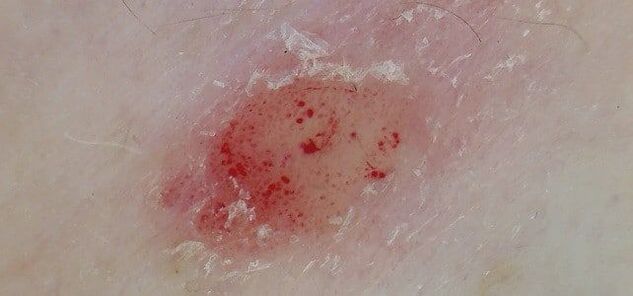
These three characteristic manifestations distinguish scalp psoriasis from seborrheic dermatitis, with which it can easily be confused. In the future, the papules merge, forming psoriatic plaques, which have a different configuration and sometimes spread to the entire surface of the head.
The course of psoriasis of the scalp can be mild with the appearance of isolated rashes in the initial stages. These rashes then go through all three stages of development. In severe form, rashes occupy the entire significant area and spread to the face and neck in the form of a crown - an inflammatory rim covered with silvery scales. The hair roots do not suffer, but the psoriasis process is often accompanied by a bacterial, fungal or mixed infection, which leads to complications that are not so easy to cure. The crown looks like this:
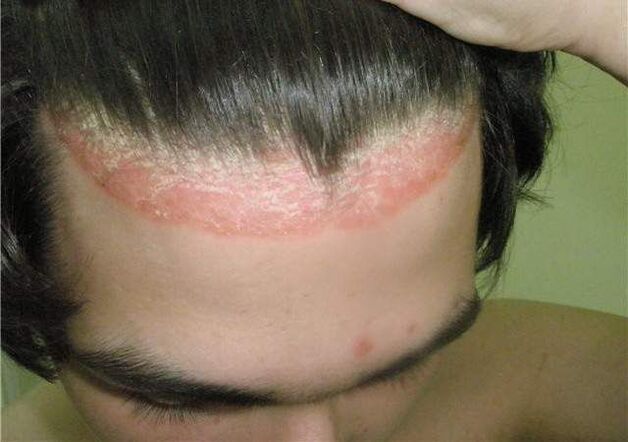
Stages of psoriasis on the head
The disease lasts a long time, exacerbations are replaced by remissions. The frequency of exacerbations and the severity of symptoms depend on the presence of provoking factors.
Progressive Stage
The rash and inflammation spread, accompanied by severe itching. At the initial stage there is a symptom of Koebner - the appearance of psoriatic rashes at the site of scratches and abrasions.
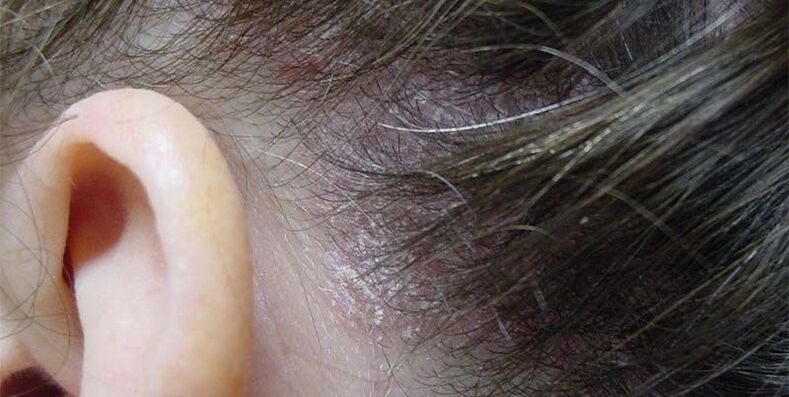
Stationary
The process is in the same state, does not spread, but also does not fade.
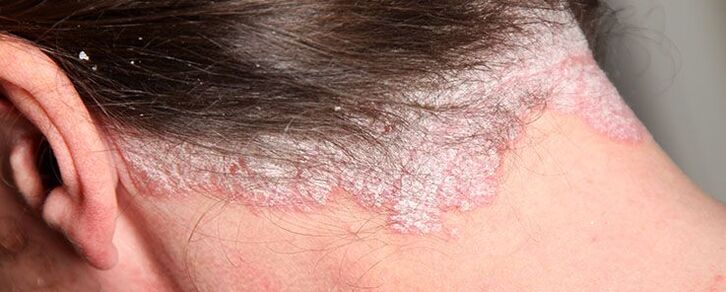
Regressive
The process gradually subsides, the itching disappears, the rash turns pale, the inflammatory infiltrate decreases and gradually acquires the appearance of a spot; The color of the rashes becomes pale, starting from the center, forming ring-shaped figures with a lighter border. Sometimes they begin to turn pale from the periphery to the center, and then take the form of whitish rings (a symptom of psoriasis on the head is Voronov's pseudoatrophy). The healing phase can take quite a long time and gradually only white depigmented patches remain on the skin.
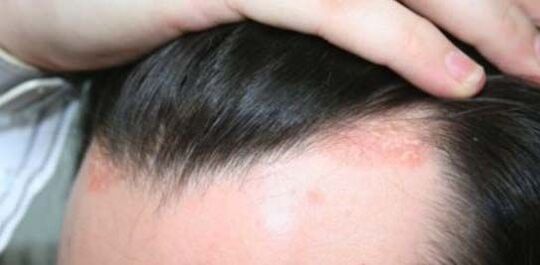
Methods of treating psoriasis on the head
Scalp psoriasis requires systematic treatment under medical supervision. A mobile lifestyle, smoking and alcohol cessation, diets are crucial. It is necessary to treat the disease in a complex way, using techniques that take into account the characteristics of the patient's body. Complex therapy can include modern European methods, drug treatment, as well as oriental methods that have been tried and tested for centuries. Such treatment can immediately significantly improve the patient's condition and lead to the development of stable remission within a few weeks.
PRP - Therapy - The method is based on the ability of platelets (red blood platelets) to secrete a growth factor that stimulates the regenerative abilities of the cells. The patient's blood is enriched with blood platelets by centrifugation and then injected into the scalp at specific points. The technique can significantly accelerate the onset of remission and prevent the development of relapses.
Autohemotherapy - treatment is carried out by intramuscular injection of a small amount of blood from the patient's vein. This has a general stimulating effect, restores the epithelium of the head. Stable remission is observed after treatment.
Reflexology is the act of acting in various ways on specific points on the body that are reflexively associated with organs and tissues. One of the oldest and most effective traditional treatment methods. The effects on the points can be acupuncture (acupuncture), cauterization, massage, etc. The treatment of psoriasis on the head with these methods has been practiced in oriental medicine for thousands of years. The treatments are carried out by a reflexologist.
Vacuum therapy - the effect of rarefied air on biologically active points - is one of the methods of reflexology. It can be done with cans or special devices. Promotes rapid recovery from altered tissue. Through the use of vacuum therapy, the affected areas are significantly reduced.
Phytotherapy - Dermatologists often use medicinal plants in their practice in the form of infusions, decoctions and ready-to-use medicinal forms. With proper use as part of complex treatment, they are very effective both in the initial stages of the disease and in its long-term forms. If you add phytotherapy, the effectiveness of other methods of treatment increases, the risk of developing adverse drug reactions decreases.
Treatment of psoriasis on the head in the clinic
In a specialized clinic, this disease is treated by dermatologists who are trained and clinically experienced in the treatment of this disease using all currently known methods. In their work they use new Western methods of medical treatment combined with traditional Eastern methods that have been used successfully by physicians of ancient China and Tibet for millennia.
In order to avoid recurrence, it is necessary to eliminate the cause of the disease
Professional clinics use a variety of methods with an individual approach to each patient. Several complexes of traditional methods in combination with drug treatment can permanently save the patient from problems with the scalp.
The effectiveness of treatment in the clinic is noted in its comments and reviews not only by patients who regularly receive supportive care, but also by colleagues from other Moscow clinics.
Prevention of psoriasis on the head
Prevention of psoriasis on the head is especially necessary for people with hereditary predisposition who have sick relatives. It includes eliminating the effects of the following factors:
- any prolonged contact with the skin;
- malnutrition and lack of exercise;
- prolonged stress and heavy loads;
- smoking and alcohol abuse;
- hormonal disorders - if you suspect such disorders, you should immediately contact an endocrinologist;
- Intoxication - timely treatment of any chronic diseases that contribute to impaired metabolism and immunity.
A dermatologist, after an examination, can tell you how to cure psoriasis on the head. Therefore, you should not hesitate with the advice of a specialist, since the initial stages of the disease are much easier to treat. Can we heal this process? It is completely impossible to cure the disease, but if a person receives regular treatment, there is a great opportunity to get rid of relapses for a long time.
Diet for head psoriasis?
There is no specific diet, but treating scalp psoriasis involves eating 4 proper meals a day, containing all the ingredients the body needs in the diet. Foods that irritate the skin should not be on the table:
- hot, salty, sour;
- Fruits rich in essential oils (fresh garlic and onions, radish);
- fried, smoked, canned;
- Caffeinated beverages - strong tea, coffee, Coca-Cola, etc. ;
- alcoholic beverages - they contribute to the development of relapses of the disease.
It was found that meat food provokes aggravation, so the diet should include more foods containing complex carbohydrates, lean meat, cottage cheese, yogurt, etc.
Drug therapy for scalp psoriasis?
The choice of drugs depends on the patient's condition and the presence of certain symptoms of the disease. At the initial stage of psoriasis on the head, the following external means are used:
- when wet, solutions and creams are prescribed that eliminate these symptoms and prevent bacterial and fungal infections;
- if the skin is dry, it is treated with ointments; Ointment with salicylic acid - has a softening effect; Ointments with tar have the same effect; Ointments with zinc and an analogue of vitamin D3 + glucocorticoid betamethasone help a lot - it helps to quickly eliminate the symptoms of psoriasis;
- Ointments and creams containing corticosteroid hormones are prescribed to treat common forms of psoriasis on the head;
- Shampoos are common; so tar shampoos relieve inflammation, soften crusts; Shampoo with zinc has an antiseptic and softening effect, relieves inflammation; Shampoos have been used for a long time.
Folk remedies for psoriasis on the head?
Is it possible to treat psoriasis of the scalp with folk remedies? Most specialists use folk remedies for symptomatic treatment (elimination of certain symptoms) of this disease. But this must be clear to you:
- it is necessary to treat the disease with folk remedies on the recommendation of a dermatologist;
- it is impossible to cure the disease with folk remedies alone; Dermatologists prescribe complex therapy in combination with traditional medicine.

























